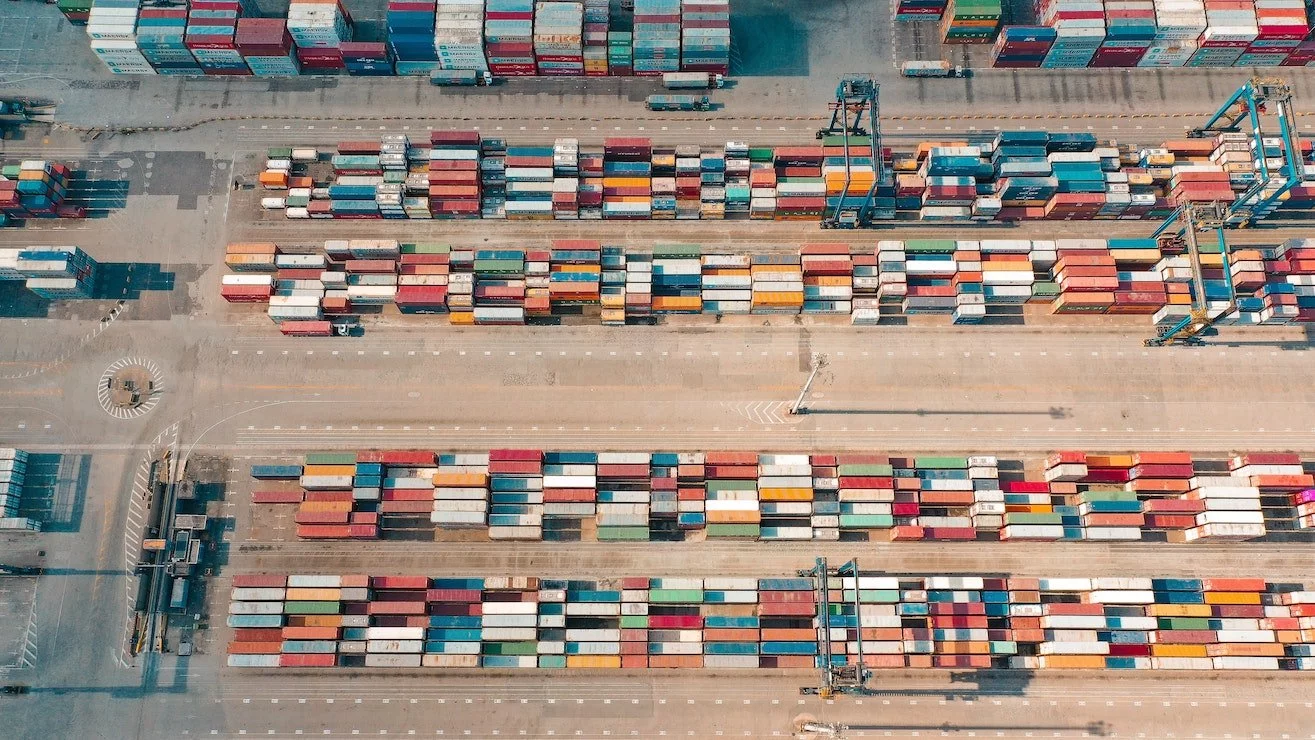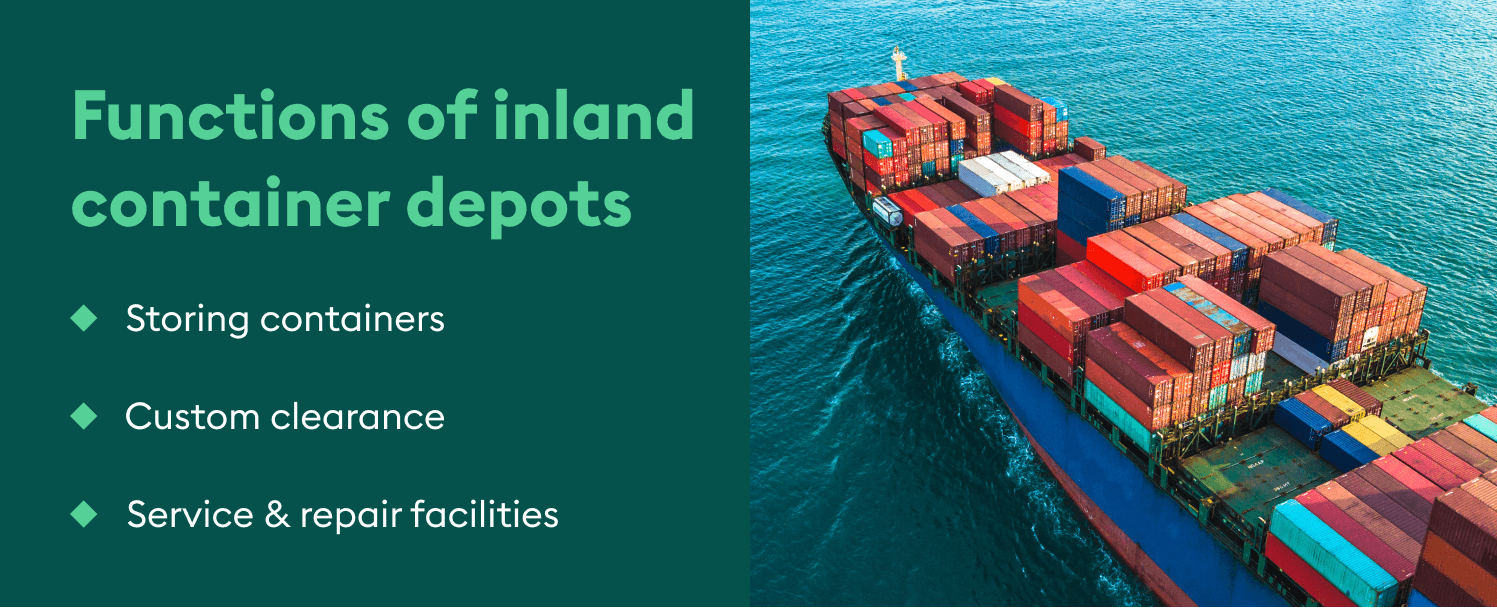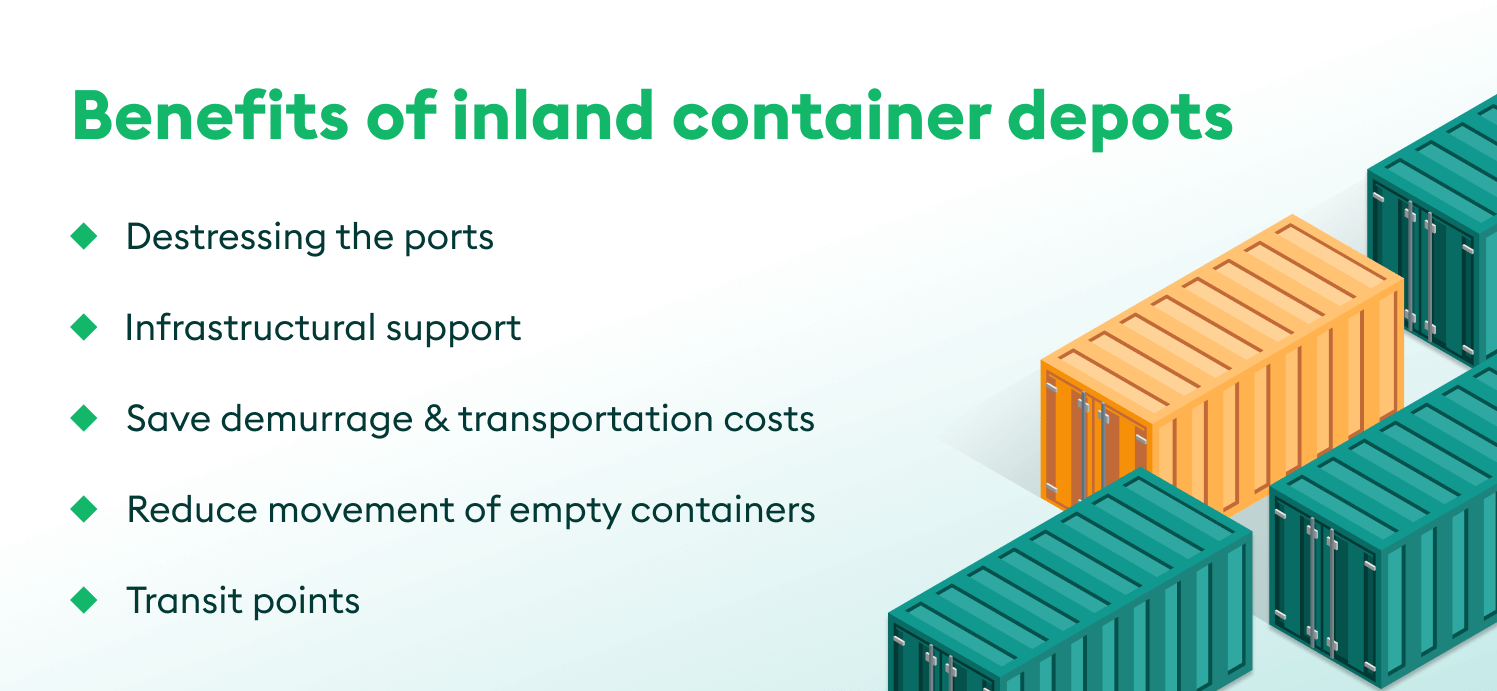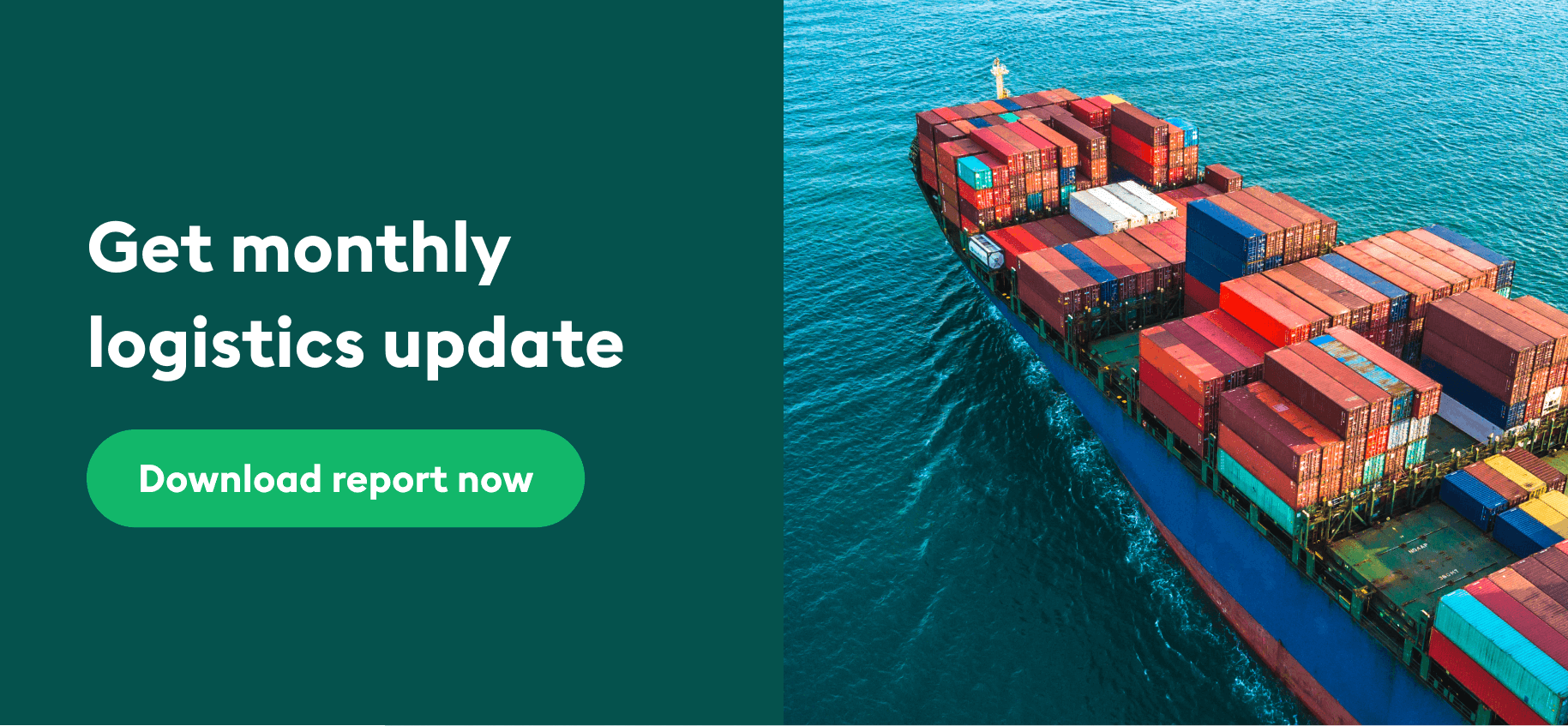Inland container depots (ICDs) provide a storage facility for containers on the hinterlands. Read this blog to know all about ICDs, including their functions and benefits.
ICDs play a key role in the shipping industry. A good network of ICDs can save freight forwarders, shipping companies and shippers a lot of money. They provide facilities for landlocked shippers to process their shipments at their own locations.
You can easily process cargo in containers at ICDs, and then move the containers to the port for shipping. In doing so, you’re planning your shipments better and reducing your chances of custom-related hold-ups at the port. This way, you can also avoid paying demurrage charges to the carriers.
However, demurrage & detention charges are unprecedented. Port delays, congestion, or lack of labor at the port can cause delays in processing your shipments. These factors are not in your hands but you can end up paying for them.
One way to avoid this is to use shipper-owner containers (SOCs). When you use a SOC, you don’t have to worry about unexpected demurrage and detention costs.
You can easily lease SOC containers at Container xChange–an online container marketplace where you connect with vetted members in 2500+ locations to lease, buy and sell containers.
All you have to do is enter your pick-up and drop-off locations, and container type in the public search below. You can then take your pick from a list of containers, suppliers, and current leasing rates. And get your SOC in just a few clicks at the best rates!
What is an inland container depot?
An inland container depot (ICD) or a dry port is a container storage facility situated mainly on the hinterlands, away from any major ports. Many shipping companies store their containers in ICDs before and after transporting them through ports.
ICDs are very well connected with ports through rail and road.
You’ll find it interesting to know that these facilities have all the necessary clearance and documentation for storing cargo. Plus, ICDs help hinterland shippers and consignees receive port services closer to their premises. This helps them process their shipments in their factories or godowns – thereby decongesting ports where the storage spaces are limited.

You may confuse ICDs with container depots, which are usually near ports. Both ICDs and container depots serve the same function. The only difference is that ICDs are in the hinterlands, whereas container depots are near ports. You can read more about container depots here.
|
Did you know: According to our latest report, 40.4% of industry experts believe that container depots may remain congested this year with containers, causing a lack of space. This may increase the demand and usage for ICDs in the hinterlands. |
Why is an inland container depot important?
Inland container depots can help freight forwarders and shipping lines to reach out more customers in the hinterland. For example, ICDs play a huge role in the USA for landlocked state shippers by providing them with facilities to arrange their shipments away from the ports. Additionally, organising cargo in-house and sending them to ports saves money for both freight forwarders and their clients.
Functions of an inland container depot
Let’s look at some of the main functions of ICDs.

- Storing containers: Have you wondered where shipping containers go after reaching the destination port? Or where do they come from before reaching the ports? Well, ICDs provide a storage facility for containers at various transit points. You can even store your specialized cargo at ICDs. It’s best to do your research to ensure whether an ICD can accommodate your special container and cargo.
- Custom clearances: You know that every shipment requires custom clearance. Most freight forwarders try to arrange the required documents before the containers reach the port to be shipped. This helps in reducing the shipping costs and helps them plan their shipment better. As we mentioned before, most of the services that you can avail at a port can be availed at an ICD. This also includes getting container clearance for your shipment.
- Servicing and repairing facilities: Even the sturdiest of boxes can incur damage during the shipping process. If unchecked, container damage can create a huge financial loss for both the owner and the user of the container. That’s why ICDs provide facilities where you can survey and repair your containers before they’re taken to the port to be shipped.
|
Pro tip: We provide container survey services and container insurance for your containers. Want to know more? Click here and talk to our experts about how we can help you in your shipping process. |
Advantages of inland container depots
Now that we’ve looked at various functions of ICDs, let’s take a look at the benefits of inland container depots.

Destressing the ports
Port congestion can cause port delays which ultimately disrupt the entire supply chain. The more popular a port is, the more likely it will become congested due to the increase in container volume. One way of decongesting the ports is to use inland container depots. They can provide space for empty containers that otherwise clutter the main ports.
Infrastructural support
Another major benefit of having a strong network of ICDs is that they act as a feeder infrastructure for the ports. In doing so, they support the growing imports and exports and act as a resource contributing towards the economic development of a country.
Save demurrage and detention costs
Freight forwarders and shippers are well aware of the dreaded demurrage and detention charges. You pay these charges to the shipping lines when you exceed the use of carrier-owned containers (COCs). They continue to add up on a per-day basis and can easily exceed $100 per day!
According to our latest report, ports may face congestion this year and containers exceeding their dwell times can face increased demurrage and detention charges.
One way to avoid these charges is to use ICDs. This way, you can plan your shipments better and pass customs beforehand – reducing your chances of custom-related hold-ups at the port. Thus, saving you demurrage charges from the carriers.
However, another way to avoid D&D charges is to use shipper-owned containers (SOCs). These containers are owned by shippers or freight forwarders. SOCs are a great way to avoid D&D charges and regain control over your logistics operations.
On Container xChange, you can easily connect with 1500+ vetted members and lease SOC containers on your desired route. By simply stating your requirements like pick-up and drop-off locations, you’ll find multiple container deals to choose from.
|
Want to check out the one-way SOC leasing deals on your route? Click here to choose the best deals and save on D&D charges. |
Reduce movement of empty containers
For container owners, the movement of empty containers has a substantial economic downside. Every year, it costs the shipping industry more than $20 billion. To reduce this, inland container depots provide consolidation facilities for LCLWhat is less than container load? Less than container load (less than container load, LCL) is a shipping term that refers to the delivery of cargo in smaller quantities than a full container load. A f... More shipments in the hinterland and provide an affordable storage space for empty containers.
Container owners can also lease out their empty containers – and use the ICD facility for the handover of containers to the user. But how do you find users to lease out your containers? Well, on Container xChange we provide you with an online marketplace to put up leasing offers. On our platform, you can find vetted partners in 2500+ locations globally to lease your containers. Click here to check out how you can put leasing offers yourself.
Intermodal transportation
Another major benefit of inland container depot is that it acts as a transit point for shipments. ICDs can function as major hubs for not only consolidating cargo but also for shipments via rail or road. So if you have a shipment that needs to be transported somewhere far from a major port, ICDs can offer the right equipment and personnel to handle your cargo efficiently.
Now that we’ve looked at the benefits of ICDs, let’s understand how ICDs are different from container freight stations (CFS).
Difference between container freight station and inland container depot
Even though these are two different terms, it can get confusing to differentiate between the two, as both function as consolidation points. If you’re not sure about the difference between ICD and CFS either, take a look at the table below.
|
Container freight station vs inland container depot |
|
| Container freight station | Inland container depot |
| In most cases, the CFS is located close to the port of entry. | ICD is in the hinterlands away from the main ports. |
| It is mainly used for consolidation and segregation of cargo. It mostly deals with any LCLWhat is less than container load? Less than container load (less than container load, LCL) is a shipping term that refers to the delivery of cargo in smaller quantities than a full container load. A f... More cargo needs. | ICD mostly serves FCL cargo needs and can also be connected to road and rail transport. |
| The main aim of CFS is to decongest the port. It also provides rail and road connectivity. | It helps you avail the customs-related services along with consolidation and storage of cargo. |
Now that you’re well aware of the importance of inland container depots, the next step is to keep up with the latest developments in the shipping industry so you can plan your logistics better. Read on to see how we can help you with that.
Want regular container logistics updates? Read our monthly report
At Container xChange, we’re constantly trying to make the process of shipping easy and profitable for our members. To assist you with that, we regularly publish container logistics research reports each month.
In these reports, you get information about the latest global events impacting the shipping industry. You get insights on container prices, availability and market trends. Plus, we publish predictions about the coming months so you can plan your logistics better and make more profits!
For example, our latest 23 Shipping Trends in 2023 report mentioned that manufacturing industries will shift their business to other viable locations in Asia like Vietnam or India. This is to reduce solely relying on China for production capacity and skilled manpower.
This gradual shift will, in turn, increase the number of container and inland container depots in these countries. As the exports will increase, so will the demand for proper infrastructure to manage them.
Now imagine getting this valuable information (and more) month-on-month without having to research on your own. All you’ve to do is click the banner below to get your free copy of our latest logistics report.
Inland container depot: Common FAQs
What is an inland container depot?
An inland container depot (ICD) is a container storage facility situated on the hinterlands, away from any major ports.
What are the benefits of an inland container depot (ICD)?
ICDs provide storage facilities for containers thereby destressing the ports and reducing the port charges. They also provide infrastructural support for intermodal transportation and can help reduce the movement of empty containers.
What are the functions of inland container depots?
An inland container depot's functions include providing container storage, customs clearance for shipments, and facilities for container maintenance and repair.



